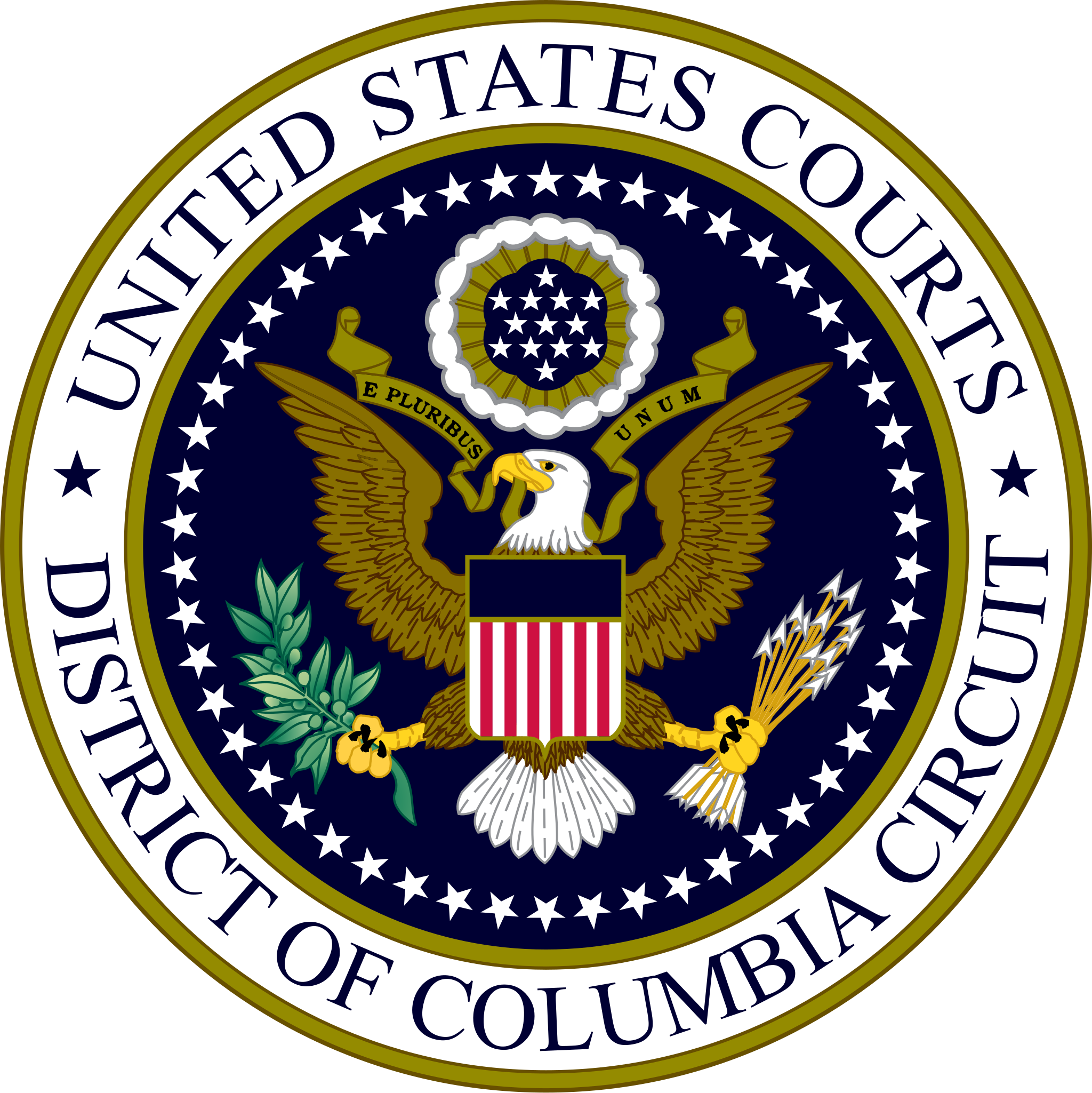Wie bereits am Mittwoch berichtet (Abschnitt 3.), hatte der District Court für den District of Columbia durch den von Trump nominierter Richter Trevor Neil McFadden am 08.04.2025 vorläufig zugunsten von AP wegen ‚Golf von Mexiko / Gulf of America – Berichterstattungsmöglichkeiten aus dem Weißen Haus und dem Präsidenten-Flugzeug Air Force One‚ (zur Vorgeschichte siehe meine Artikel vom 24. und 25.05.2025) entschieden:
„Paintiff’s [27] Amended Motion for Preliminary Injunction is GRANTED;
and it is further ORDERED that
1. Defendants shall immediately rescind the denial of the AP’s access to the Oval Office, Air Force One, and other limited spaces based on the AP’s viewpoint when such spaces are made open to other members of the White House press pool.
2. Defendants shall immediately rescind their viewpoint-based denial of the AP’s access to events open to all credentialed White House journalists.
3. This preliminary injunction shall remain in effect until further order of this Court.
4. This preliminary injunction issues without the requirement of any security bond.“
https://storage.courtlistener.com/recap/gov.uscourts.dcd.277682/gov.uscourts.dcd.277682.46.0_1.pdf, S. 41; Hyperlink hinzugefügt)
Zugleich hatte das Gericht seine eigene Entscheidung aus Eigeninitiative bis „April 13, 2025 [außer Vollzug gesetzt], to provide the Government time to seek an emergency stay from a higher court and to prepare to implement the Court’s injunction“.
Die Trump-Regierung hat umgehend Rechtsmittel-Einlegung ankündigt und inzwischen auch die Außer-Vollzug-Setzung der District Court-Entscheidung für die gesamte Dauer des Rechtsmittel-Verfahrens sowohl beim District Court selbst als auch beim zuständigen Appeals Court beantragt.
Der District Court hat den Antrag – nach Stellungnahme von AP – bereits abgelehnt:

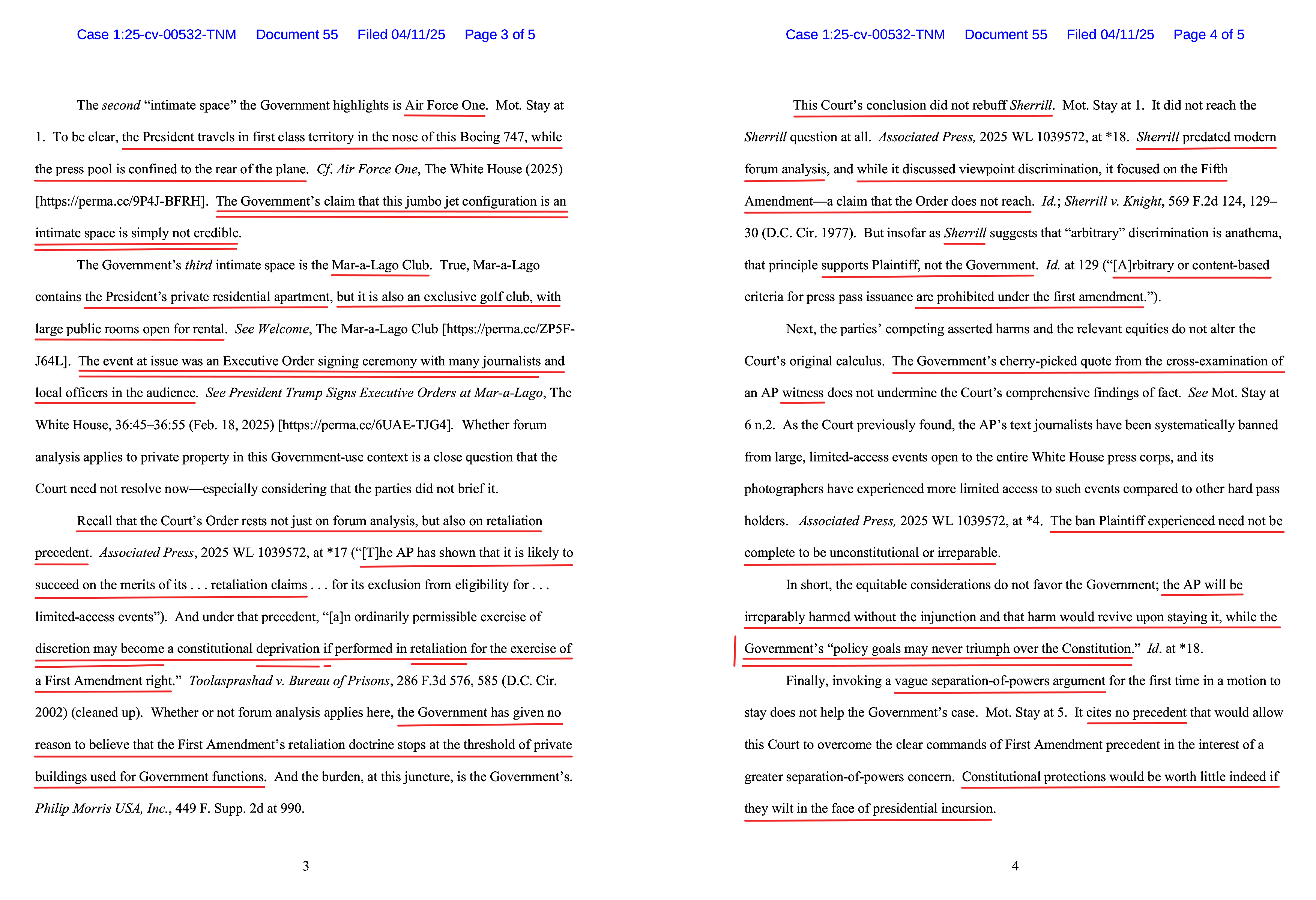
https://storage.courtlistener.com/recap/gov.uscourts.dcd.277682/gov.uscourts.dcd.277682.55.0_1.pdf (5 Seiten)
Antrag, Antwort und Rück-Antwort für den Appeals Court sind im Folgenden verlinkt:
Der stay-Antrag der Regierung
Gliederung:
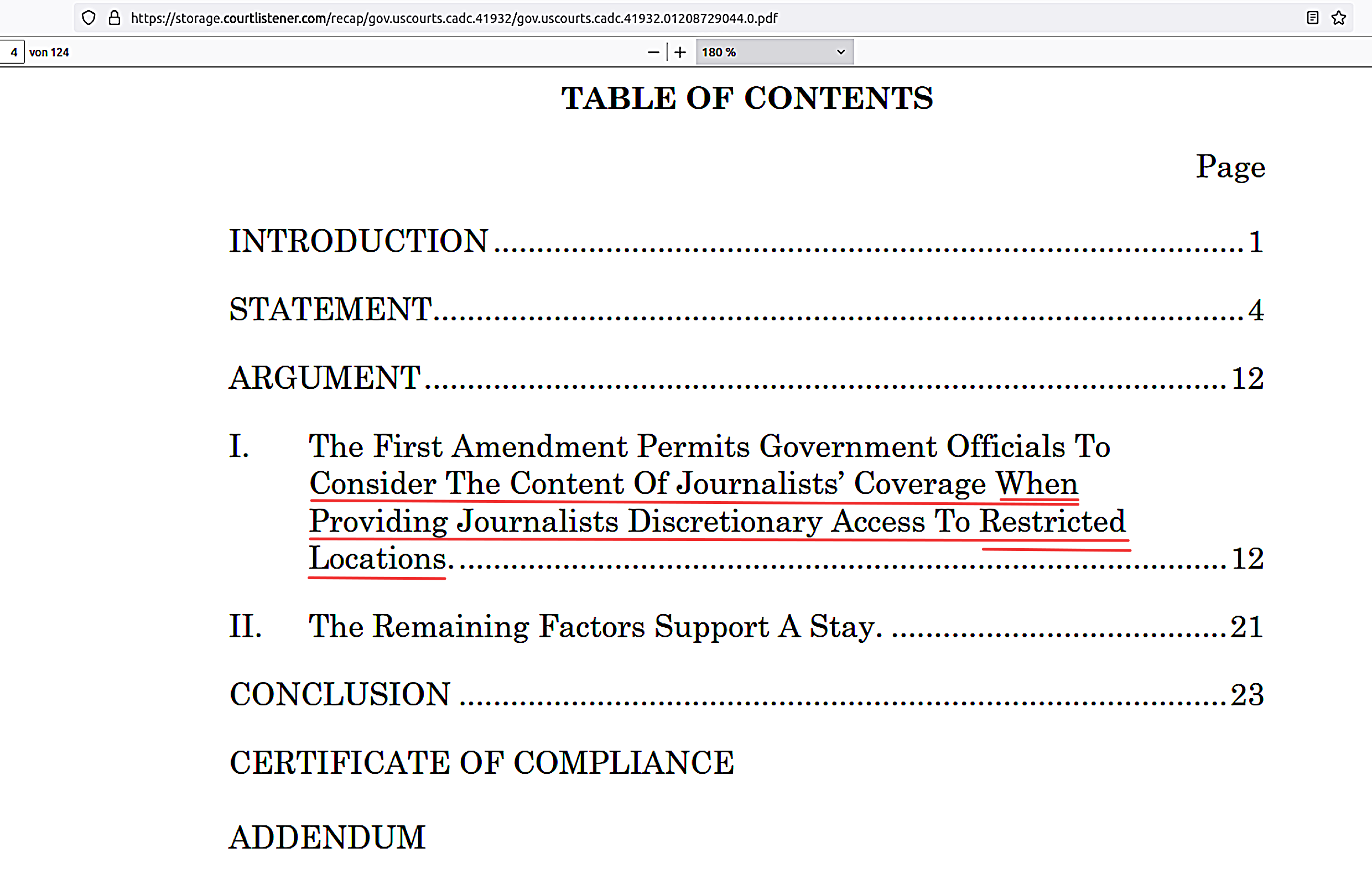
Anfang der Einleitung:
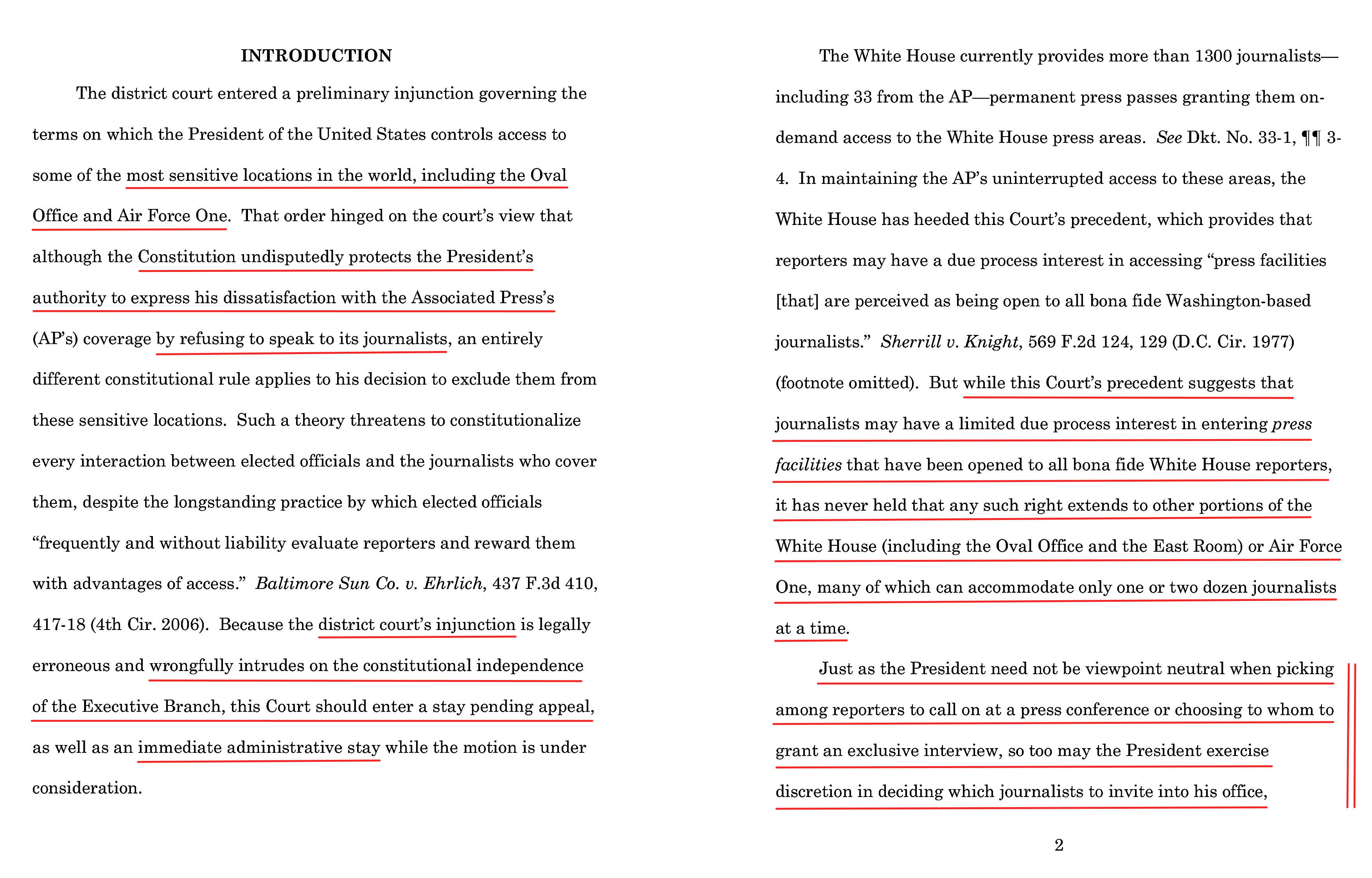
Die gesamte Datei:
https://storage.courtlistener.com/recap/gov.uscourts.cadc.41932/gov.uscourts.cadc.41932.01208729044.0.pdf 29 Seiten + 95 Seiten Anlagen
Die Regierung sieht einen Widerspruch darin, daß
„the Constitution undisputedly protects the President’s authority to express his dissatisfaction with the Associated Press’s (AP’s) coverage by refusing to speak to its journalists,“ (Hv. hinzugefügt)
daß aber – nach Ansicht des District Court –
„an entirely different constitutional rule applies to his decision to exclude them from these sensitive locations.“
(Dazu hatte der District Court in seiner Ablehnung des dortigen stay-Antrags der Regierung u.a. gesagt:
„The first so-called intimate space the Government addresses is the Oval Office. But the Oval Office is not just a ‚personal workspace.‘ […]. It is the President’s formal office, to which Defendants regularly invite a rotating group of 21 journalists for ‚pool sprays‘ and historic meetings with world leaders. […]. e President has other personal workspaces to which Defendants do not routinely invite a gaggle of reporters. […]. Those are truly ‚intimate spaces,‘ and they are so precisely because Defendants do not regularly invite in prying reporters and the like.
The second ‚intimate space‘ the Government highlights is Air Force One. […]. To be clear, the President travels in first class territory in the nose of this Boeing 747, while the press pool is confined to the rear of the plane. […]. The Government’s claim that this jumbo jet configuration is an intimate space is simply not credible.
The Government’s third intimate space is the Mar-a-Lago Club. True, Mar-a-Lago contains the President’s private residential apartment, but it is also an exclusive golf club, with large public rooms open for rental. […]. The event at issue was an Executive Order signing ceremony with many journalists and local officers in the audience.“
(https://storage.courtlistener.com/recap/gov.uscourts.dcd.277682/gov.uscourts.dcd.277682.55.0_1.pdf, S. 2 f.; Hv. i.O.)
Die Antwort von AP
Gliederung:
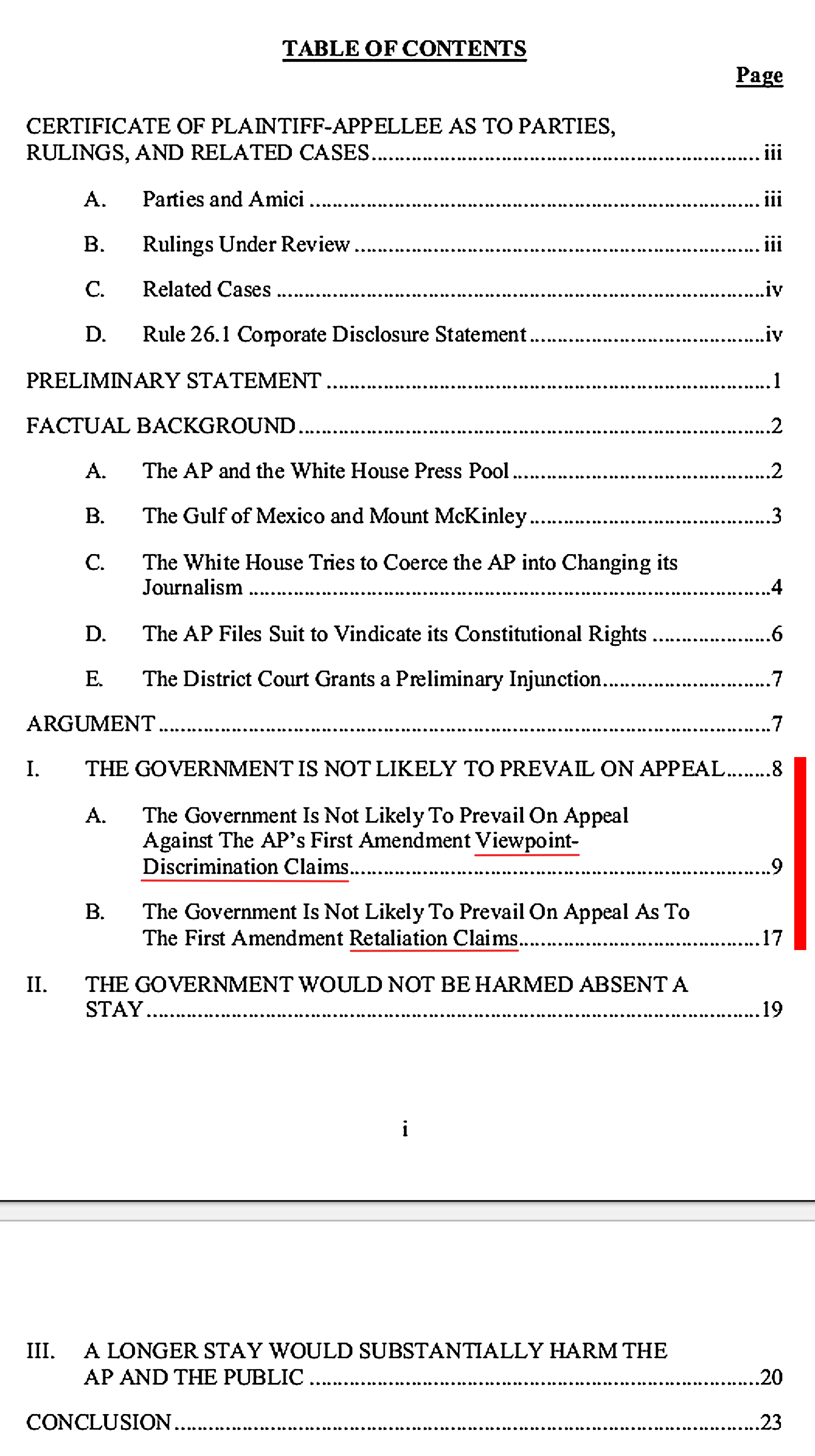
Perlimary Statement (und Anfang des folgenden Abschnittes):
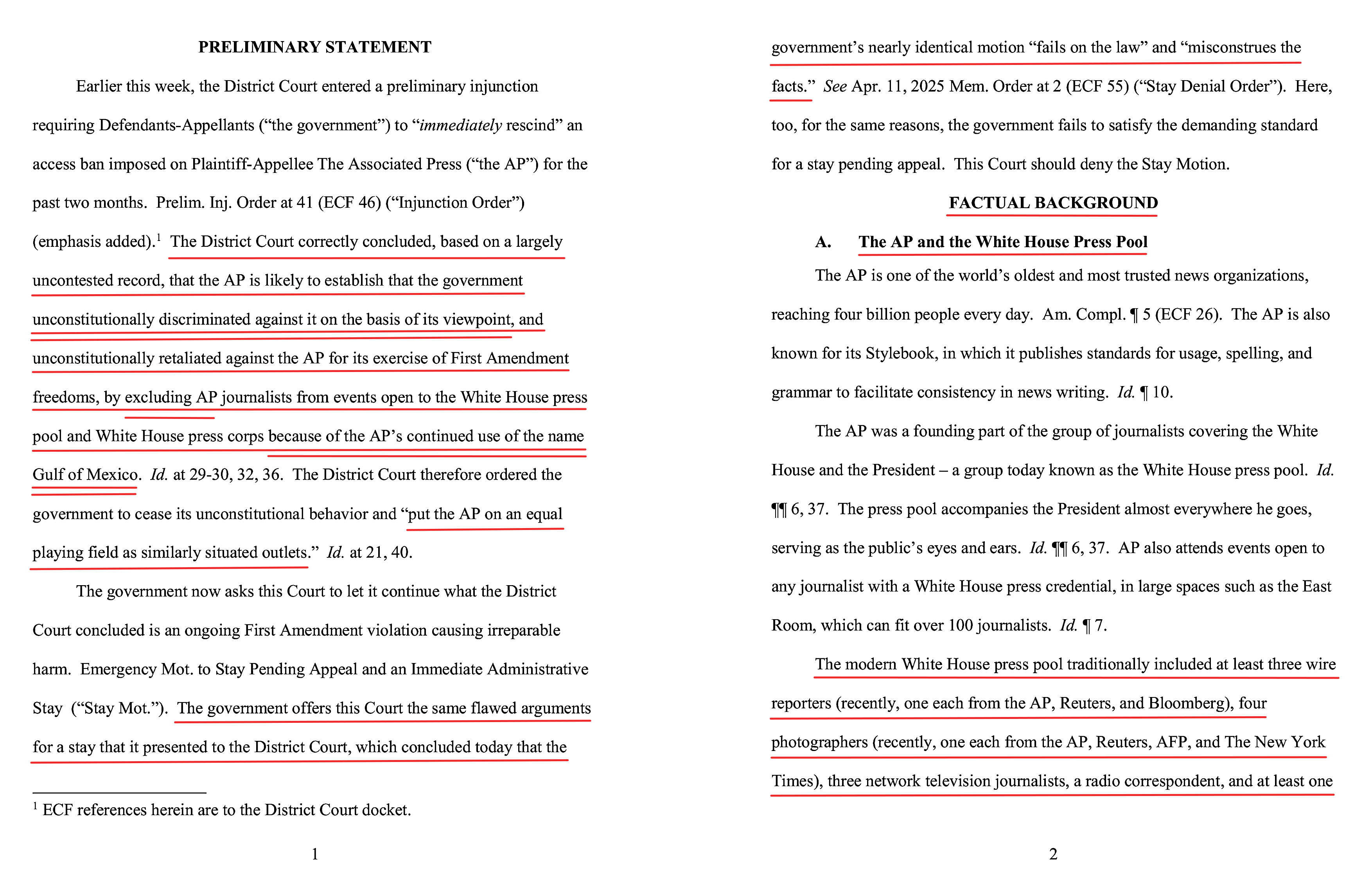
Die gesamte Datei:
https://storage.courtlistener.com/recap/gov.uscourts.cadc.41932/gov.uscourts.cadc.41932.01208729581.1.pdf (30 Seiten)
AP sagt u.a.:
„The District Court correctly concluded, based on a largely uncontested record, that the AP is likely to establish that the government unconstitutionally discriminated against it on the basis of its viewpoint, and unconstitutionally retaliated against the AP for its exercise of First Amendment freedoms, by excluding AP journalists from events open to the White House press pool and White House press corps because of the AP’s continued use of the name Gulf of Mexico.“
„The government offers this Court the same flawed arguments for a stay that it presented to the District Court, which concluded today that the government’s nearly identical motion ‚fails on the law‘ and ‚misconstrues the facts.‘ […]. Here, too, for the same reasons, the government fails to satisfy the demanding standard for a stay pending appeal.“
Die Rück-Antwort der Regierung
Gliederung:
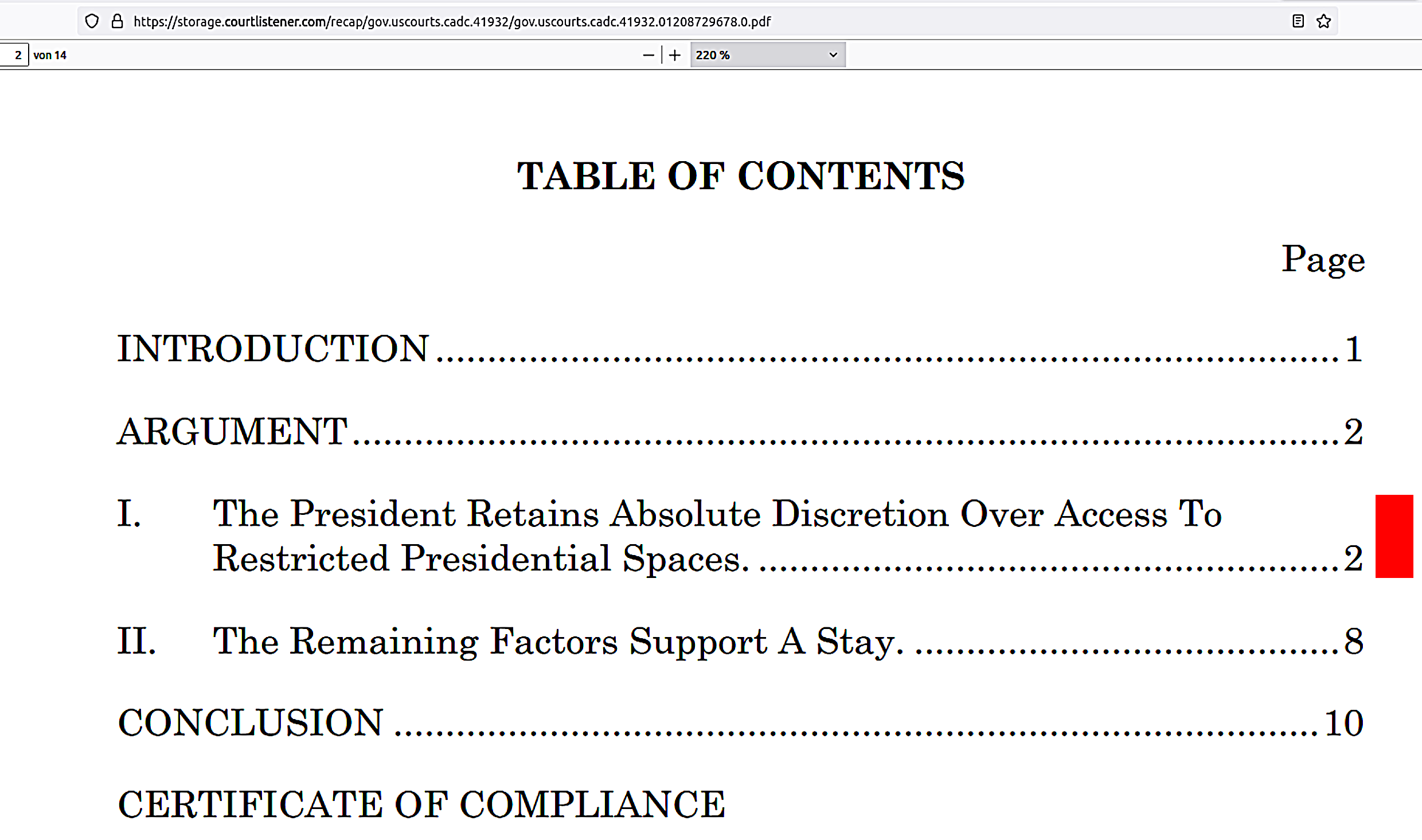
Anfang der Einleitung:
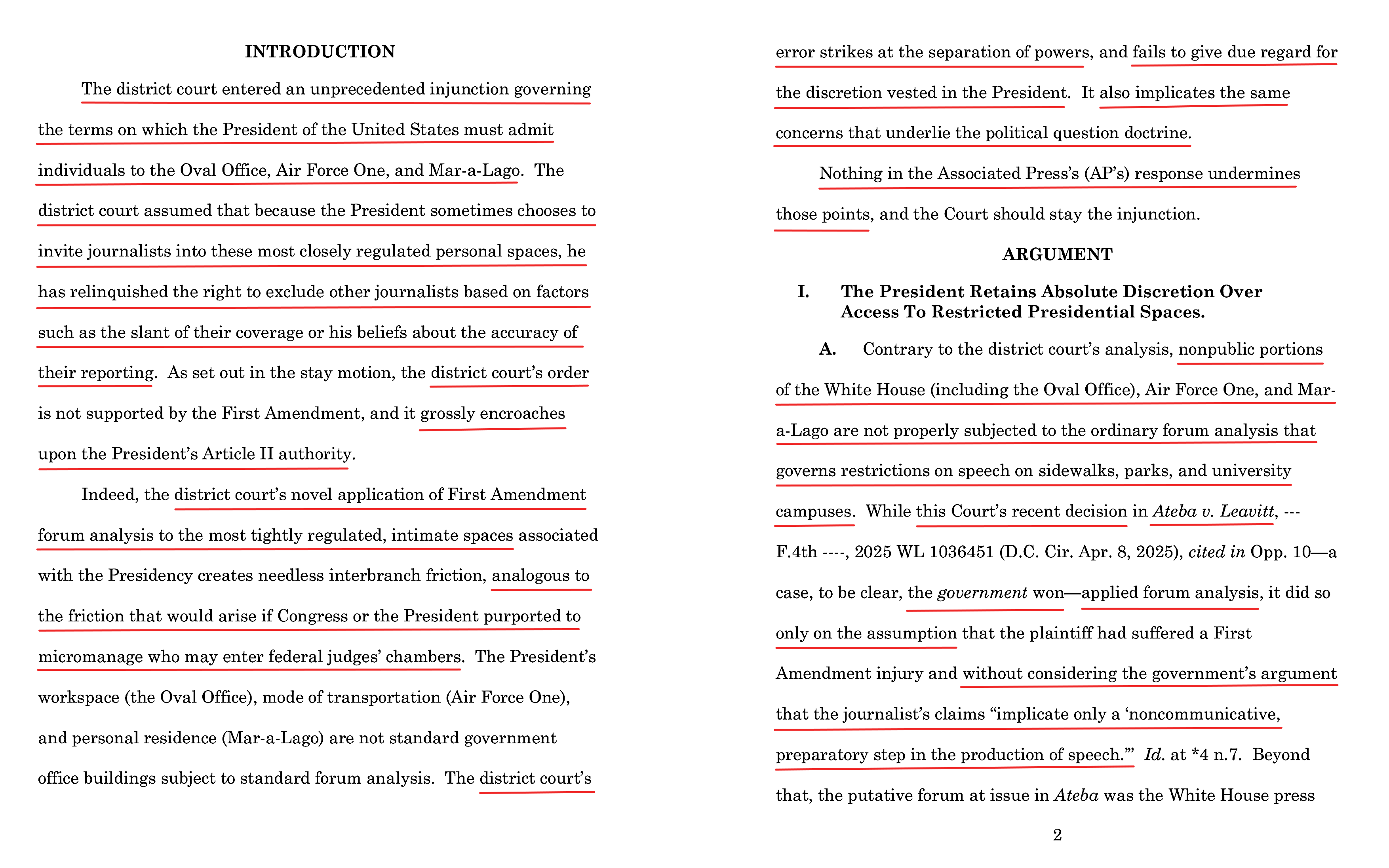
Die gesamte Datei:
https://storage.courtlistener.com/recap/gov.uscourts.cadc.41932/gov.uscourts.cadc.41932.01208729678.0.pdf (14 Seiten)
Die Regierung bleibt bei ihrer These, daß es sich bei den in Rede stehenden Räumen um „closely regulated personal spaces“, bei denen viewpoint discrimination zulässig sei:
„The district court entered an unprecedented injunction governing the terms on which the President of the United States must admit individuals to the Oval Office, Air Force One, and Mar-a-Lago. The district court assumed that because the President sometimes chooses to invite journalists into these most closely regulated personal spaces, he has relinquished the right to exclude other journalists based on factors such as the slant of their coverage or his beliefs about the accuracy of their reporting. As set out in the stay motion, the district court’s order is not supported by the First Amendment, and it grossly encroaches upon the President’s Article II authority.“
Zum Begriff der forum analysis, der in verschiedenen der verlinkten Texten vorkommt siehe:
https://www.law.cornell.edu/wex/forum.
Der Rest des Artikels ist gegenüber der ursprünglichen Fassung von Montagvormittag überarbeitet und aktualisiert.
Der Appeals Court hat bisher nicht über den Antrag entschieden, sondern hatte am Sonntag (bei courtlistener aber erst am Montag online) nur eine mündliche Verhandlung für Donnerstag angesetzt („oral argument on Thursday, April 17, 2025, at 2 P.M. before Circuit Judges Pillard, Katsas, and Rao“).
Richterin Pillard wurde 2013 von Obama nominiert; Richter Katsas 2017 von Trump und Richterin Rao 2019 von Trump.
Dadurch, daß der Appeals Court bisher keine Entscheidung über den Regierungsantrag getroffen hat, trat die District Court-Entscheidung am Montag früh um 0:00 Uhr in Kraft.
Die Trump-Regierung ist damit aber unzufrieden:

Die Antwort von AP auf den heutigen Brief der Regierung:
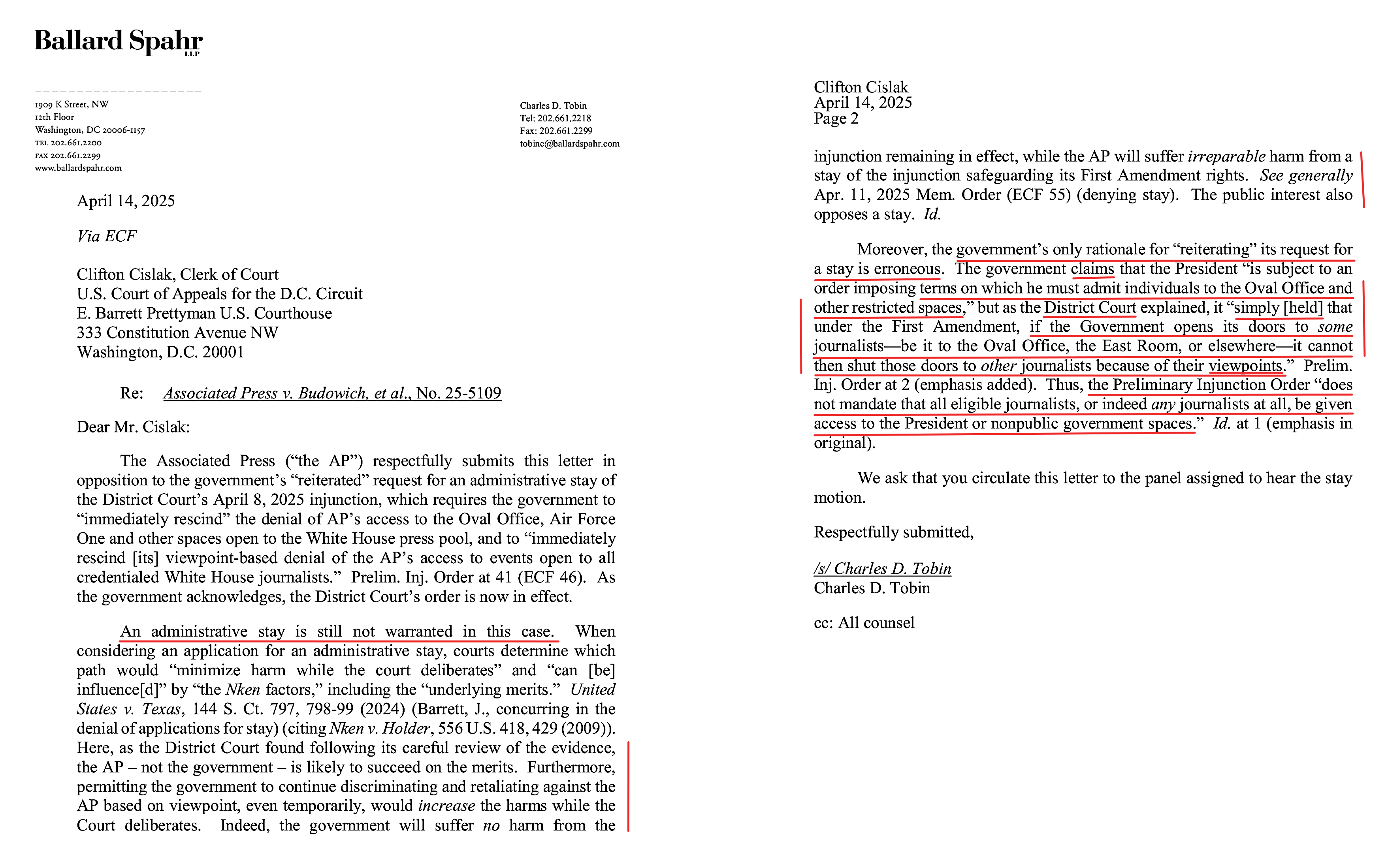
Das Schreiben der Regierung von Montag führte aber bis jetzt (Dienstag, den 15.03., 9:15 Uhr MESZ) zu keiner Reaktion des Appeals Court. Der Regierung schreint die am Montag früh in Kraft getretene District Court-Entscheidung (bisher) nicht zu beachten:
„At the WH, AP’s reporter and photographer just attempted to join the pool and were again denied access to the Oval.“
(Eli Stokols [White House + foreign policy correspondent von Politico])
